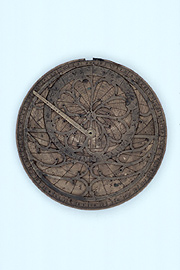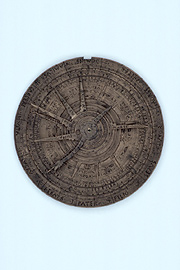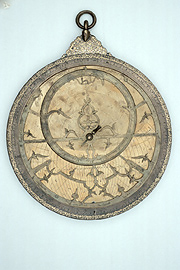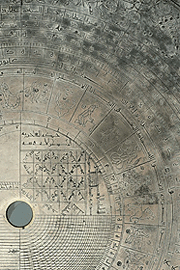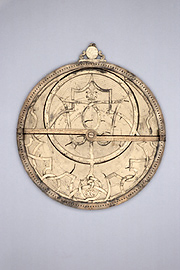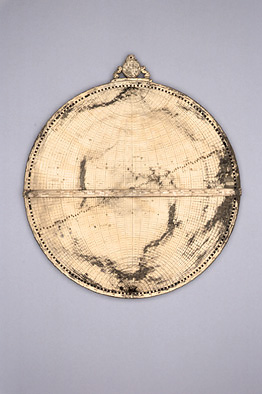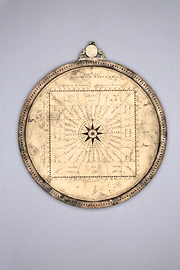|









| |
ASTROLOGY
The
astrolabe was used just as much for court and popular astrology as it
was for making purely astronomical calculations. Making predictions
about the future and casting horoscopes were activities embedded in
the social fabric of both European and Islamic societies. The astrolabe
provided a convenient way of collecting the basic information required
to accomplish such tasks. In fact, the word “horoscope” is
derived from the Greek words hora (time) and skopos (observer). The
astrolabe “observed time” through the calculation of positions
and relationships of celestial objects like the stars, sun, moon, and
planets. The users interpreted these results and made predictions about
a person’s personality, the length of their life, the progress
of their illnesses, and the failure or success of their undertakings.
The astrolabes in this exhibition illustrate these complimentary and
often overlapping roles assumed by astronomy and astrology as well as
their practitioners.
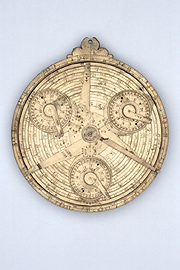 |
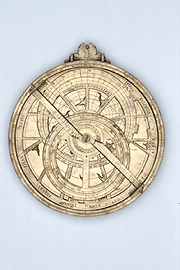 |
Equatorium
and Astrolabe
Late 15th century
Maker Unknown
Southern France or Northern Italy
Brass
Billmeir Collection
This equatorium was likely designed for medical astrology, indicated
by the additional rete and an astrolabe plate with lines for fever
prediction. The three circles on the front use Ptolemy’s
rules for planetary motion to calculate the positions of the moon,
Mercury & Venus, and Mars, Jupiter, & Saturn. The sun
is included with the stars on the astrolabe’s back, despite
Ptolemy’s belief that the Sun was a planet. |
Astrolabe
and Astrological Volvelle in brass
Late15th century
Maker Unknown
Italy
Brass
Lewis Evans Collection
This astrolabe has an unusual rete design and eight concentric
astrological volvelles on the back. The back itself is engraved
with the names and numbers of the astrological houses. The volvelles
feature a calendar and zodiac, the ruling planets for each sign,
corresponding elements, and the lunar phases. |
Astrolabe,
Syro-Egyptian
1227/8 (dated 625 A.H.)
Made by Abd al-Karim al-Misri
Location Unknown
Brass with Gold and Silver damascene work
Lewis Evans Collection
The back of this astrolabe is engraved with zodiac pictures, the
28 mansions of the moon and an astrological table. The gold inscription
on its rim is dedicated to an early 13th century ruler of Mesopotamia.
One of its plates may feature the earliest surviving tablet of
ecliptical coordinates. |
INSTRUCTION AND PAPER ASTROLABES
The
astrolabe’s instructional value and its popularity were notably
increased by the invention of Gutenberg’s printing press in the
mid-15th century. As a result of this invention, the instrument could
be easily reproduced and diffused more widely in instructional publications.
This made the astrolabe accessible to a much broader public. Students,
tradesmen and professionals could join royalty in experimenting with
its use and construction. The printing press facilitated the trade,
travel and consumption of astrolabes through these different social
groups and encouraged the use of the instrument even further into Europe.
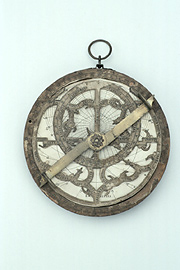 |
Paper
Astrolabe,
1542
Made by Georg Hartmann
Nuremburg
Pasteboard, Paper, Wood, and Brass
Lewis Evans Collection
Early paper instruments are rare, but there are a number extant
from Georg Hartmann. He appears to have printed the paper astrolabes
from the same plate and simply changed the year. This example
is signed on the blank rim by Leonardo Botalli of Asti, a medical
author and physician to Charles IX and Henri III of France. |
PATRONAGE
Many finely crafted astrolabes were built for wealthy patrons who could afford to support their design, production and innovation. They have been preserved as aesthetically impressive objects, often illustrating the status of their patron more than the precision of their instrumentation. Many existing astrolabes are dedicated to Islamic and European nobility and feature inscribed dedications and crests. These are often elaborately decorated and incorporated into the astrolabes� structural elements. Such impressive features often gained or encouraged the continued patronage of an instrument-maker and helped to maintain the continued importance of the astrolabe more broadly
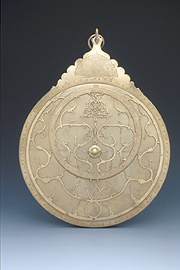 |
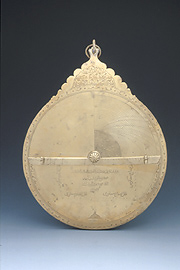 |
Astrolabe
1647/8 (dated 1057 A.H.)
Made by Muhammad Muqim al-Yazdi
Persia
Brass
Lewis Evans Collection
This 18.25 lb. astrolabe was dedicated to the Safavid ruler Shah
Abbâs II, whose name is in the ecliptic circle decoration.
An inscription on the topmost decoration is addressed to “The
supreme prince, the sul_ân, the most just, the most great,
lord of the centres of command, remover of the causes of tyranny
and rebellion, king of the kings of the age….”. |
Astrolabe
1559
Made by Thomas Gemini
London
Brass
Transferred from the University Observatory
Thomas Gemini made this astrolabe for Queen Elizabeth I. Its rete
features the Flemish tulip, and there is a Gemma Frisius style
universal projection on the back. The astrolabe was later obtained
by Nicholas Greaves, the brother of an Oxford astronomy professor,
for a scientific journey in Levant in 1637-40. |
|



